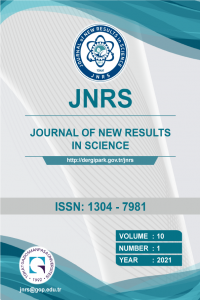EFFECTS OF DIFFERENT MINITUBER SIZE AND PLANTING NUMBER ON THE MINITUBERS YIELD AND YIELD COMPONENTS OF BASCIFTLIK BEYAZI LOCAL GENOTYPE
Potato minituber, seed potato production.,
___
- Struik, P.C., 2007. The canon of potato science: Minitubers. Potato Res. 50:305–308.
- Ranalli E, 1997. Innovative propagation methods in seed tuber multiplication programs. Potato Res 40:439-453.
- Haverkort AJ, M Van de Waart, and J Marinas, 1991. Field performance of potato microtubers as a propagation material. Potato Res 34:353-364.
- Struik PC and Lommen W.J.M., 1990. Production, storage and use of micro and mini-tubers. Proc. 11th Tri Conf of the Euro Assoc Potato Res (EAPR), Edinburg, pp. 122-33.
- Tadesse M, Lommen WJM and Struik P.C., 2001. Effects of temperature pre-treatment of transplants from in vitro produced potato plantlets on transplant growth and yield in the field. Potato Res 44: 173-85.
- Sharma AK, Venkatasalam EP, Singh RK and Singh S., 2010. Effect of variety and planting method of micro-plants on potato mini-tuber production during off-season in north-western Himalaya. Potato J 37(1-2): 28-32.
- Ahloowalia BS., 1994. Production and performance of potato minitubers. Euphytica 75:163-172.
- Millam, S. and Sharma, S.K., 2007, Potato Biology and Biotechnology Advances and Perspectives. Part VII. Biotechnology. 3.2.2. Mini tubers page: 49.
- Yurtsever, N., 1984. Deneysel İstatistik Metotları. Toprak ve Gübre Araştırma Enstitüsü Yayınları, Genel Yayın No: 121, Teknik Yayın No: 56, Ankara.
- Lommen, W.J.M., 1999. Causes for low tuber yields of transplants from in vitro potato plantlets of early cultivars after field planting. J. Agric. Sci. 133: 275-284.
- Gupta VK, Kumar S, Baishya LK and Kumar M., 2003. Effect of planting density on mini-tuber production from micro-propagated plants. Potato J 30: 43-44.
- Rykbost, K. A., and B. A. Charlton. 2004. Effect of pronuclear minituber seed size on production of Wallowa Russet seed. Potato Res. 75: 91 -96.
- Bardas, M. (2004). Studies about increasing the multiplication coefficient of seed potatoes by using mini -tubers of Romanian varieties under ecological conditions of the research and development institute for potato and sugar beet Brasov. Summary of Doctoral Thesis.
- ISSN: 1304-7981
- Yayın Aralığı: 3
- Başlangıç: 2012
- Yayıncı: TOKAT GAZİOSMANPAŞA ÜNİVERSİTESİ
Yasemin İÇMEZ, Cem EMEKSİZ, Zafer DOGAN
Hüseyin ARPACI, Ömerül Faruk ÖZGÜVEN, Mehmet Serhat CAN
Güngör YILMAZ, Ahmet KINAY, Mahfuz ELMASTAŞ
Aslı YILMAZ, Resul GERÇEKCİOĞLU, Öznur ÖZ ATASEVER
Yakup BUDAK, Medine YILDIRIM, Merve ÖRNEK, Oğuz ÖZBEK
Yasin Bedrettin KARAN, Gungor YİLMAZ
Mahmoud RAFAAT, S A EL-SHEİKH, R Ak OMAR
Hasan PINAR, Nedim MUTLU, Davut KELES, Atilla ATA, Saadet BUYUKALACA, Cansu SİMSEK
